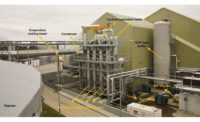Maximizing Potential
Iowa-based Oakland Foods produces a range of beef, pork, and poultry products with flexibility, efficiency, and multiple food-safety interventions.
By Barbara Young,
Editor-In-Chief
Photos by Vito Palmisano
Editor-In-Chief
Photos by Vito Palmisano
The production program at Oakland Foods LLC is defined by processing accomplishments, to be sure. Performance sets the standards governing the weekly manufacture of beef, pork and poultry products, however. The processing plant in Oakland, IA, a 300,000-square-foot facility, is capable of producing huge volumes of diverse products weekly. Although this diverse product mix is segregated into a group of profit centers, the plant is solely under the auspices of Oakland Foods LLC, owned by Aurora, IL-based OSI Group LLC.
A new general manager was assigned to the facility recently. He is Mike Koranda, who succeeded Daniel Milovanovic — now assigned to duties at corporate headquarters. Koranda may be a new member of the OSI Group team, but he is not new to the state of Iowa having been born and raised in Davenport, IA. A 30-year industry veteran, Koranda spent most of his career on the operations side of meat processing for a national food processing company at several different locations. Milovanovic recruited him.
"We're aiming for maximum flexibility to serve our customers' needs," notes Milovanovic, a member of the scouting party that found the plant in 1995. "We think of all the possibilities and then do all we can to deliver quick turnarounds. We work with a whatever-it-takes attitude. Because of that, we do a lot of what others can't do, or won't do for that matter." Milovanovic encountered the plant after it had been empty and idle for more than 10 years, which did not obscure the promise it held to become a viable production site for OSI purposes. Attractive features included the facility’s location hear a major highway system (Iowa’s Interstate 80); a structurally sound building with rooms large enough to custom design and accommodate high-tech equipment; favorable utility rates; and a short travel distance to raw material suppliers.
Today, Oakland Foods operates with 600 employees at the 90-acre site.“We have a strong and excellent management team,” boasts Todd Ryan, assistant plant manager. “The environment at OSI creates a desirable workplace.”
The plant began as a cooked sausage facility complemented by the later addition of fully cooked bacon. The product mix now includes course ground and emulsified hot dogs and sausages, beef steakette; corned beef patty; fully cooked bacon in a variety of flavors; fully cooked sausage patties and links; fully cooked hamburger patties and links; meatballs and meatloaf; and Salisbury steak in a variety of flavors, among other products.
Thanks to technology, productive workers, maximum product yields, cost-containment measures, a highly developed food-safety program, and a modern business philosophy, Oakland Foods is designed for efficiency, flexibility, and quality production. Concerning productive workers, Koranda reports that in 2003 the Oakland Foods force was a “triple-crown” winner of OSI’s internal Americas Zone’s Outstanding Safety Performance Award, along with the American Meat Institute’s Award of Honor and Award of Honor with Distinction, for operating with no loss-time cases and an incident rate of 1.9. The criterion governing the award is based on each facility’s performance on the annual Corporate Compliance Safety Assessment score, the year-end OSHA incident rate, and the facility’s worker comp cost in comparison to annual payroll.
“The OSI award is of particular significance since the competition is so fierce amongst all the Americas Zone’s facilities, which reflects the commitment to safety all OSI companies exemplify,” Koranda says.
Controlling the process involves more than supervision as Milovanovic — who was singled out as one of the Magnificent 11 in The NATIONAL PROVISIONER’s April 2004 list of extraordinary plant managers— points out.
“You have to be on top of all aspects of production including yields, throughput, pounds per-man-hour, and number of batches,” explains Milovanovic, who introduced statistical process control to the company. “Our goal is to operate efficiently by maximizing throughputs and minimizing rework and inedibles. We do it through new technology and manipulating the process”
Concerning the future, Koranda sees expansion on the horizon, as an 18,000-square-foot addition is on the drawing board. As Koranda explains, the new space will be dedicated to two vertical form, fill, and seal lines giving the plant the capability of packoff automation.
“This will mark our entrance into retail production,” Koranda says. “We also will produce bulk packaged frozen products for the foodservice industry.” Koranda expects the addition to be up and running by mid-to-late April 2005.
“OSI is expanding by putting time, energy, and talent into developing infrastructure,” he says. Although the overall plant is the size of several football fields, each specific production area is designed with a product flow for maximum food safety and efficiency.
“All raw material and the employees that work in the raw areas are segregated from the cooked and finished product. Even the welfare areas are segregated into “raw” and “cooked”. With a few exceptions, the production processes are in-line continuous flow.
“When raw material is removed from the holding cooler to begin the manufacturing process, our objective is to keep the product moving through the blending, grinding, forming, stuffing, cooking, freezing, and packaging and onto the truck to be delivered to our customers,” Koranda says. “Food safety is key to Oakland’s success and every step of our production process is monitored by quality assurance personnel. HACCP [Hazard Analysis and Critical Control Point] is the cornerstone of producing safe wholesome products that we are proud to deliver to our customers.” NP



Report Abusive Comment